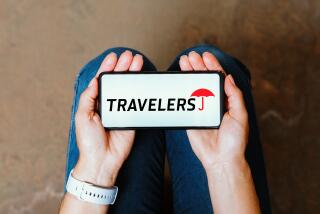Hotels, Spas Shift Focus to Home Crowd
With foreign visitors shying away and many Americans nervous about airplane trips, California’s tourism industry is refocusing marketing efforts on its own backyard.
California’s 34 million residents constitute a “drive market”--visitors who live within driving distance--that tourism officials say is unparalleled in the nation.
Though not as free-spending as long-distance travelers, they represent a reliable source of business that travel agents, hotels and attractions are eager to tap.
The Hotel del Coronado near San Diego, for example, has scrapped planned ad campaigns geared for such cities as Chicago and Dallas in favor of more print advertising aimed at Southern Californians, said Craig Jacobs, director of sales and marketing.
“In the short term, we’re going to be focusing on the drive market almost exclusively,” Jacobs said. “Those are the people most likely to be receptive.”
State tourism officials have come to the same conclusion, launching a state-funded marketing program aimed at getting Californians to travel and spend much-needed tourist dollars in the Golden State. The $5-million campaign, announced by Gov. Gray Davis on Saturday, will fund radio, television and print ads that will begin appearing throughout the state this month.
State residents are the California industry’s best customers. More than 80% of the 293 million “visitors” here last year were Californians, the vast majority of them traveling by car. These home-grown tourists give California a decided advantage over such leisure hot spots as Hawaii, a thinly populated paradise whose tourist industry depends almost exclusively on out-of-state air travelers.
Still, the loss of big-spending foreign visitors and the slump in business travel has the California tourism industry searching even harder for customers close to home.
“Our best hope is to get Californians visiting California,” said Michael Collins, executive vice president of the Los Angeles Convention and Visitors Bureau. “We need to take advantage of the drive market and encourage [people] to get up and get moving.”
A lot is at stake. Travel and tourism are pillars of the California economy, with visitors’ expenditures topping $75 billion last year--about 6% of California’s gross state product. The industry is the state’s third-largest employer, providing work for more than 1.1 million people.
Massive layoffs have begun here and across the nation as the meltdown in air travel spreads to the rest of the industry. In response, industry veterans are turning their attention to the drive market to drum up business.
For Orange County travel agent Bev Zukow, that has meant crafting drive packages for clients to places such as Napa Valley instead of the Hawaiian and European destinations that are her bread and butter. Though such trips are less profitable, she said many clients are simply reluctant to fly or stray far from home in the wake of the Sept. 11 terrorist attacks.
Rather than “sit and twiddle my thumbs,” Zukow said, she has been researching destinations up and down the West Coast. Better to have people traveling shorter distances than not at all, she reasons.
“We need to overcome this fear of traveling . . . and smaller trips can help with that,” said Zukow, owner of Villa Park-based First Travel of California. “People are going to discover what’s right in front of them.”
Indeed, some industry watchers predict an increase in old-fashioned family car trips, which could prove an opportunity for California’s regional attractions.
“We’re going to see a return to more traditional family things,” said travel marketing consultant John Poimiroo, former head of the state’s tourism division. “Instead of Hawaii or Europe, people are going to be thinking of the old beach house, resort or state park they visited as kids.”
High in the San Bernardino Mountains, the owners of Apples Bed & Breakfast at Big Bear Lake say they’ve already seen a surge of inquiries from people looking for what they consider a quick and secure getaway. Recent guests include a Las Vegas family who drove to the 13-room property after flights to San Francisco had been canceled. Another couple has arranged to hold their wedding at Apples after scrapping plans for November nuptials in Hawaii.
“The phone has just been crazy,” said Apples co-owner Barbara McLean, who added that nearly every available room has been booked for weekends in October. “They say they just need a break and think Big Bear was a real safe destination.”
At the Ojai Valley Inn & Spa, business in September has dropped by 20% compared with the same month last year. But October reservations are holding up, partly because the 210-room resort has picked up guests from the Los Angeles area, said managing director Thaddeus Hyland.
“We’re lucky in so many ways to be close to L.A.,” said Hyland, whose property draws about 60% of its guests from Southern California. “We have groups sticking a little bit closer to home until things have relaxed a little bit.”
He said the resort’s sales staff has all but halted efforts to attract business from such places as New York or Chicago given the current wariness of people to travel long distances.
With security and family now foremost in many consumers’ minds, hotels that previously touted themselves as romantic getaways are now encouraging visitors to bring the whole gang. Four Sisters Inns, which manages 11 inns in California and Washington state, is waiving the $20 additional-person fee it usually charges people traveling with children.
“People want to be close to their children right now,” said Four Sisters President Shelley Post Claudel. “We want to encourage that.”
Los Angeles and San Francisco in particular are looking to grab a bigger share of in-state travelers to help fill the gaping hole left by the lack of foreign visitors. It won’t be easy. Though small in number compared with natives, foreign visitors stay longer in hotels and spend more money.
In Los Angeles County, for example, foreign tourists account for an estimated 22% of all tourists but nearly one-third of visitor spending.
Rodney Fong, whose family owns wax museums in San Francisco and Buena Park, has teamed up with competing attractions to lure more in-state visitors to San Francisco’s Fisherman’s Wharf to compensate for the dramatic drop in visitors from overseas. He said the group is running newspaper ads in cities such as Fresno, Sacramento and Bakersfield and even reaching out to jaded locals who tend to avoid tourist haunts.
“This is our window to reach them,” Fong said. “We’re offering good old-fashioned family fun.”
He said the Fisherman’s Wharf museum already has seen an increase in local visitors, which he attributes to residents’ desire to stay near home as well as to the attraction’s $12.95 admission.
More to Read
Sign up for The Wild
We’ll help you find the best places to hike, bike and run, as well as the perfect silent spots for meditation and yoga.
You may occasionally receive promotional content from the Los Angeles Times.






